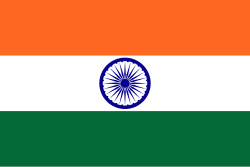Top Qs
Timeline
Chat
Perspective
List of Indian flags
From Wikipedia, the free encyclopedia
Remove ads
This is a list of flags used in India by various organizations.
Wikimedia Commons has media related to Flags of India.
National flag
Governmental flag
Remove ads
Supreme Court
Ensigns
Naval
Port authorities
Remove ads
Military flags
Summarize
Perspective
Indian Armed Forces
Indian Army
Indian Navy
Current rank flags (2022-present)
Former rank flags (1950-2001; 2004-2022)
Former rank flags (2001-2004)
Indian Air Force
Current rank flags (1980-present)
Former rank flags (till 2023)
Former rank flags (1950-1980)
The former IAF rank flags were modeled on those of the Royal Air Force, with different colours.[7]
Coast Guard
Paramilitary forces
Other agencies
Remove ads
Former Flags of Indian Armed Forces
State and union territory flags
Summarize
Perspective
At present there are no officially recognised flags for individual states and union territories of India. No legal prohibitions to prevent states adopting distinctive flags exist in either the Emblems and Names (Prevention of Improper Use) Act, 1950 or the Prevention of Insults to National Honour Act, 1971.[9] In a 1994 case before the Supreme Court of India, S. R. Bommai v. Union of India, the Supreme Court declared that there is no prohibition in the Constitution of India for a state to have its own flag. However, a state flag should not dishonour the national flag.[10] The Flag code of India also permits other flags to be flown with the Flag of India, but not on the same flag pole or in a superior position to the national flag.[11]
Former official state flags
The state of Jammu and Kashmir had an officially recognised state flag between 1952 and 2019 under the special status granted to the state by Article 370 of the Constitution of India.
Proposed state flags
Flags have been proposed for Tamil Nadu and Karnataka, but neither were officially adopted.
Banners of the states and union territories
When a distinctive banner is required to represent a state or union territory, the emblem of the state or union territory is usually displayed on a white or blue field.[15][16][17]
Remove ads
Historical flags
Dominion of India
Political flags
National parties
Remove ads
House Flags
Remove ads
Sports
Educational Institutions
Sainik Schools
Central Universities
See also
Notes
References
External links
Wikiwand - on
Seamless Wikipedia browsing. On steroids.
Remove ads
































































































































